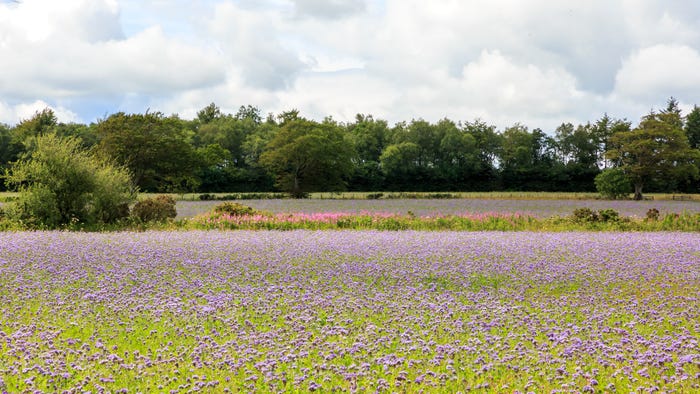The dairy industry embraces the “regenivore” movement
Regenerative agriculture in the dairy industry is an emerging trend that focuses on environmental sustainability, animal welfare and fair treatment of agricultural communities, while showcasing the transformative potential of regenerative practices to create a more sustainable and equitable food system. Here’s how large and small producers and conservation organizations are working together to benefit animals, people and the environment.

At a Glance
- Regenerative dairy practices benefit the environment by improving soil health, increasing carbon capture and more.
- Regenerative dairy improves animal welfare, particularly for cows, which live longer, healthier lives with this method.
- Regenerative dairy aims for social fairness, seeking to treat farmers more ethically by offering them financial incentives.
The latest food trend doesn’t just focus on what nutrients consumers put in their body. It widens the lens to look at what food and beverage production extracts from people and places, and what can be done to help make that process more sustainable for everyone involved.
The New York Times recently named “regenivore” its 2023 food “word of the year,” highlighting a movement of eaters who makes food choices motivated by three priorities:
Actively healing the planet through soil enrichment and carbon-reducing agriculture.
Prioritizing animal welfare.
Fair treatment of the people who grow and process food.
Balancing these priorities is a tall order for any industry, but especially one as vast and resource-intensive as the dairy industry. Industry insiders believe regenerative dairy isn’t just possible — it’s inevitable.
Small-scale farms: Managing pasture, soil
Regenerative agriculture promises a lot of earth-friendly benefits: improved soil quality, water and capturing carbon from the atmosphere. When implemented properly, “nature actually handles a lot of the complexities,” according to Tim Joseph, founder of Maple Hill Creamery, America’s first and largest grass-fed organic dairy brand.
On small-scale farms utilizing a regenerative approach, farmers rotate cows strategically from pasture to pasture to “import fertility” from manure. “Every season that you do this, it adds more organic matter, more grass, more water holding capacity and more biodiversity, simply by managing those cows properly,” Joseph said.
Regenerative agriculture comes with some costs, of course. In the dairy industry, the biggest is day-to-day productivity. Joseph said his grass-fed cows produce around 35 to 38 pounds of milk per day, as opposed to 75 to 85 pounds in conventional dairy, and around 50 pounds from grain-fed organic.
The regenerative approach, however, more than makes up this gap in the long term. The lifespan of a cow in a traditional dairy is 2 to 4 years, whereas Maple Hill’s cows regularly live three times as long — and some even get close to a cow’s natural lifespan of 15 to 20 years.
“We have cows that are teenagers and they’re still producing,” Joseph explained. These healthier, more active cows also incur less cost in veterinarian bills and hoof trimming each year along the way.
In 2023, Maple Hill received a $20 million the United States Department of Agriculture (USDA) grant to launch a Pay for Progress program to help small farms convert to regenerative practices. Producers can apply at the Pay for Progress site.
Conventional farms: Focusing on feed crops
To make a large environmental impact, small pasture-focused farms aren’t enough. Conventional dairies also need to take steps in a more regenerative direction. Many of the farmers running these operations are “extremely receptive” to doing so, according to Alisha Staggs, dairy program director for The Nature Conservancy’s North America Agriculture Program.
Through the program Dairy Feed in Focus, The Nature Conservancy works with farms of all sizes — from 50 head to thousands — to reduce carbon emissions and increase carbon capture. In addition to offering financial incentives and cost share options, farmers can choose from a “menu” of regenerative practices, including:
Regenerative crop management, such as cover crops, reduced/no till and diversified rotation.
Edge-of-field practices to enhance habitat and biodiversity.Grazing management, irrigation management and feed management plans.
Grazing management, irrigation management and feed management plans.

In the last year, Dairy Feed in Focus has implemented regenerative practices on over 10,000 acres serving about 20,000 cows, Staggs said. The organization’s success rate of enrolling farms after an in-person visit is nearly 90%. The biggest “win,” however, is in the flood of scientific data these farms create.
“Farmers are helping us to create scientifically proven examples of the best agronomic and farm management practices that will serve as models for practice implementation on dairy farms of all sizes through the U.S. and beyond,” Staggs explained. “While the idea of carbon-neutral dairy products is certainly ambitious, The Nature Conservancy believes it’s possible, and so does the dairy industry.”
Regenerative agriculture: Better for people, too
The third leg of the regenivore stool — being better for agricultural communities — can be trickier to grasp than the environmental and animal health benefits. Sustainability and sourcing consultant Udi Lazimy said it makes perfect sense to the farmers he works with. Generations of financial debt and decreasing yields from depleted soil has left many professionals in the agricultural workforce desperate for a better approach.
“There’s been a tremendous exodus off the farms, and a lot of people are simply sick and tired of it,” Lazimi said. “It’s a pretty easy connection for people to make that if you can find a way to use fewer harmful chemicals and less intensive mechanization, you’re also creating a healthier, more supportive system for the labor force.”
Joseph echoed this sentiment, explaining how farmers tell him that the transition to a regenerative approach is tough, but it’s also a far more pleasant day-to-day experience than conventional farming.
“They always tell me, ‘There’s no way I’m going back to the other way,’” he said. “It’s just a higher quality of life in the long run for everyone involved.”
Growing out rather than up
In recent years, a number of certifications have been developed to help meet a consumer demand for regenerative products that, according to the SPINS 2024 Trends Report, has been growing 20% or more annually.
The largest and most stringent is the Regenerative Organic Certification (ROC), which includes dozens of brands such as clothing makers Patagonia and prAna, as well as a range of coffee and food producers. While Regenerative Organic Alliance Executive Director Elizabeth Whitlow said the certification is making significant inroads in meat and other animal products, the dairy industry remains “difficult,” as “dairy is a little bit slower on the uptake.”
A big reason why isn’t necessarily environmental, but rather human. “There are a lot of farmers who find that the social fairness standards tend to butt up against a lot of their home values, especially when it comes to gender equity and things like that,” she explained.
As a veteran of the early days of organic certification in California, Whitlow said she’s seen firsthand how the financial side of regenerative farming can quickly make it make sense: “In the beginning, all the guys were sitting around the diner, drinking coffee and laughing at those couple of kooks who were out there rotating the cows.
"Then, they see that the feed truck isn’t going out to George’s anymore because he’s using grass,” she went on to say. “They see the milk truck is going out there over and over again. They see that George has a new pickup and that his kids are coming back to the farm. That’s what compels a farmer — and that’s what is making this move happen faster and faster.”
About the Author
You May Also Like

